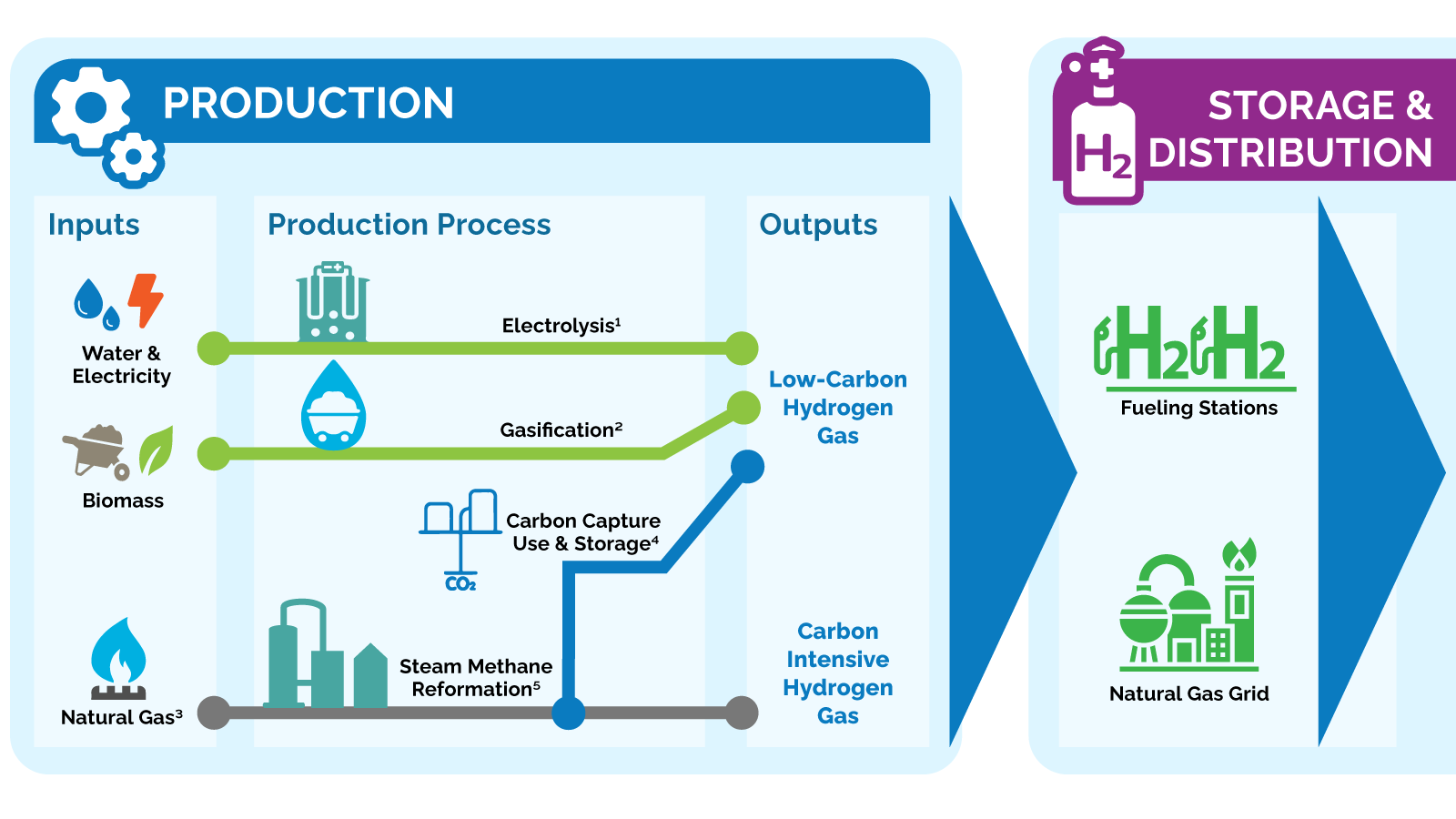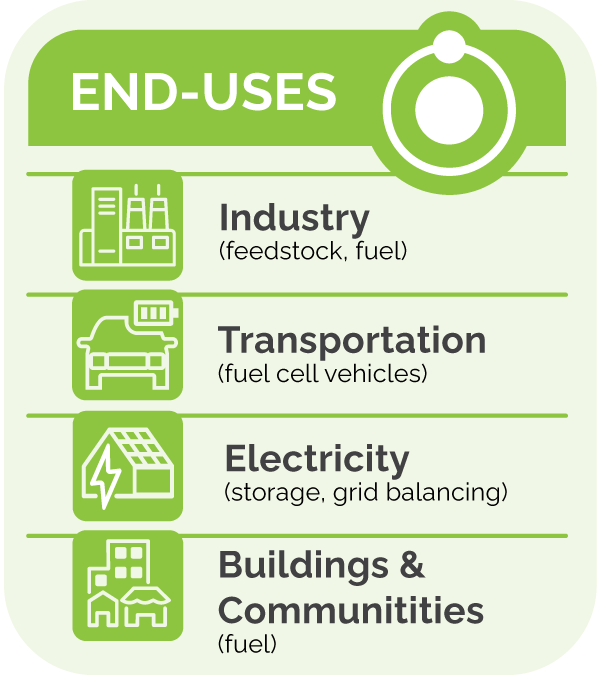Low-carbon hydrogen
Learn about low-carbon hydrogen and Ontario’s plans for a hydrogen strategy.
Ontario's hydrogen strategy
Ontario is looking at ways to further support the clean technology sector, as part of the evolution of our environment plan and our commitment to support Ontario's economic recovery while reducing greenhouse gas emissions.
To help ensure this sector can continue to grow and create jobs, we released Ontario's first low-carbon hydrogen strategy. The strategy outlines concrete and immediate actions that will accelerate the development of a low-carbon hydrogen sector in Ontario that will:
- create more local jobs
- attract investment
- help reduce greenhouse gas emissions.
The strategy incorporates feedback from our Hydrogen Strategy Working Group. It also builds on a discussion paper that was released in Fall 2020 which received a broad range of input from stakeholders, including:
- industry
- academic institutions
- environmental organizations
- the public
Read Ontario's Low-Carbon Hydrogen Strategy.
What is hydrogen
Hydrogen is the first element on the periodic table, and it makes up about 75% of mass in the universe.
Hydrogen is usually bonded to another element. For example, water is made of hydrogen and oxygen bonded together. To make pure hydrogen that can be used, for example as fuel, energy is usually needed to release hydrogen from the other elements it bonds to. Once hydrogen is released, it creates hydrogen gas which is composed of two hydrogen atoms (H2).
How low-carbon hydrogen is made
Low-carbon hydrogen is hydrogen that is made in a way that creates little to no greenhouse gas emissions. This means that low-carbon hydrogen has a smaller carbon footprint than hydrogen made from methods that leave a large carbon footprint.
There are a few different ways to make low-carbon hydrogen, including electricity and water or biomass.
Electricity and water
Industries can use electricity to split hydrogen and oxygen that make up water, to create pure hydrogen. If the source of the electricity is low-carbon (like Ontario's clean electricity grid), this results in zero or near-zero greenhouse gas emissions.
Biomass and steam
Biomass is a renewable resource that includes:
- organic waste
- agriculture leftover materials (e.g. seed pods, leaves)
- forestry leftover material (e.g. damaged wood, small stems)
Industry can use steam and oxygen to convert biomass into carbon monoxide, carbon dioxide, and hydrogen. When the resulting carbon monoxide reacts with water, it forms more carbon dioxide and hydrogen, which can be further separated out.
Natural gas and steam with carbon capture use and storage
Traditionally, hydrogen has been created using fossil fuels like natural gas. Industry uses heat to split up the molecules in steam and natural gas and create carbon monoxide and hydrogen. Steam is then added to the carbon monoxide to produce more hydrogen.
To reduce the carbon footprint of hydrogen produced this way and make low-carbon hydrogen, producers could use carbon capture use carbon capture, use and storage technology, such as permanently storing captured carbon in underground salt caverns.
Once produced, this low-carbon hydrogen can be moved or distributed by pipeline, truck, rail, or ship.

This diagram depicts four different ways of producing hydrogen. Low-carbon hydrogen can be made using water and electricity through a process called electrolysis, using biomass through a process called gasification or adding carbon capture use and storage to a carbon intensive way of producing hydrogen. Carbon intensive hydrogen is made using fossil natural gas through a process call steam methane reformation. After hydrogen is made, it can be stored and distributed by fuelling stations or the natural gas grid.
How hydrogen is used
Low-carbon hydrogen can be used in a variety of sectors and applications in Ontario, including in your home.
Buildings and communities
Low-carbon hydrogen can be blended into the natural gas pipeline to heat space and water in our homes and businesses, making Ontario's natural gas cleaner.
Industry
Low-carbon hydrogen can be used as a replacement for fossil fuels that are used in high-temperature industrial applications, such as in the production of steel and cement.
It can also be used as a replacement for hydrogen with a higher carbon footprint that is used as a chemical input in fertilizer production and in oil refineries.
Transportation
About 75% of Ontario's 2019 greenhouse gas emissions come from energy use for transportation, buildings and industry. Low-carbon hydrogen can be used in these sectors to replace fossil fuels, like diesel and gasoline, which are used to power cars, trucks, ships, and trains. This complements battery technology, which Ontario continues to develop through business investment and increased production capacity.
Electricity
Low-carbon hydrogen can be used for different electricity applications, including:
- backup, portable and auxiliary power
- systems for storing renewable energy and balancing the electricity grid
- a replacement for diesel generators, including those used in remote communities that are not connected to the electricity grid

Uses for hydrogen include as a feedstock and fuel in industry, in fuel cell vehicles for transportation, for storage or grid balancing for electricity, and as a fuel for buildings and communities.
Benefits of using low-carbon hydrogen
Reducing greenhouse gas emissions
Low-carbon hydrogen can be produced and used with little to no greenhouse gas emissions. Hydrogen is versatile and can be a clean fuel alternative or complement to fossil fuels like coal, natural gas, diesel and gasoline over the medium- to long-term (2030 to 2050).
Creating jobs
Ontario is well-positioned to drive growth in a low-carbon hydrogen economy.
We already have a clean electricity supply supported by an extensive natural gas distribution system and several hydrogen-related projects and companies that are established or in development. This will help Ontario continue to attract further investment in the hydrogen and clean technology sectors, creating jobs across the province.
Hydrogen Strategy Working Group
We established a Hydrogen Strategy Working Group to help inform the development of our hydrogen strategy. We held nine meetings with this group between February and June 2021, after which the group's work was completed.
This working group built on the input we received through the public consultation process and Ontario's hydrogen discussion paper. Members provided advice on how to use hydrogen across various sectors and help Ontario compete in the global hydrogen market.
The working group consisted of experts from industry and academia. Members included:
- Atura Power
- Canadian Hydrogen and Fuel Cell Association (CHFCA)
- Canadian Steel Producers Association (CSPA)
- Cummins
- dynaCERT Inc.
- Emerald Energy from Waste
- Enbridge Gas
- EPCOR Utilities Inc.
- Evolugen
- GE Gas Power
- H2GO Canada
- Hydrogen Business Council of Canada
- Hydrogen Optimized
- Independent Electricity System Operator (IESO)
- Nuclear Innovation Institute
- Ontario Clean Technology Industry Association (OCTIA)
- Ontario Environment Industry Association (ONEIA)
- Ontario Power Generation (OPG)
- Ontario Public Transit Association
- Ontario Trucking Association
- Ryerson University
- Toyota
- Transition Accelerator
- TC Energy
Contact
Individuals or organizations who would like to provide us with additional information or more feedback can email us at hydrogen@ontario.ca.